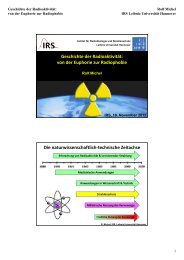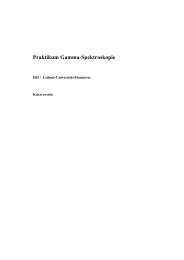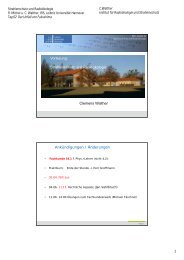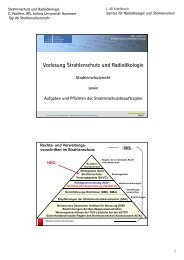Erfolgreiche ePaper selbst erstellen
Machen Sie aus Ihren PDF Publikationen ein blätterbares Flipbook mit unserer einzigartigen Google optimierten e-Paper Software.
GLOSSAR 259<br />
Expressions<br />
Besetzungsinversion Population Inversion in physics, the redistribution of atomic energy levels that<br />
takes place in a system so that laser action can occur. At finite temperature the relative fraction<br />
of atoms in excited states (population) follows the Boltzmann distribution law with the<br />
majority of atoms in low energy states. Higher levels are less populated. Although absorption<br />
and emission of energy is a continuous process, the statistical distribution (population) of<br />
atoms in the various energy states remains constant. When this distribution is disturbed by<br />
prferentially ‘pumping’atoms to higher energy levels at the cost of lower ones, a population<br />
inversion is achieved in which more atoms will exist in the higher energy states than in the<br />
lower. (Eq. (1.0)) [p. 5]<br />
Breakdown threshold The lowest power density It that suffices to initiate a breakdown for a colloid<br />
of certain properties (size, → MPI cross-section, → ionisation energy). B.t. is also equally<br />
used for the lowest mean power (Pt) of a laser or the lowest pulse energy (Et) which initiates<br />
a breakdown. (Eq. (7.14)) [p. 202]<br />
Brewster Winkel Brewster’s angle. When light passes a transparent surface a certain fraction is<br />
reflected, depending on polarization and angle of incidence. For parallel polarized light (i.e.<br />
polarized in the plane of reflection) the reflection is supressed completely for Brewster’s<br />
angle ΦB, given by tan ΦB = n. (n is the index of refraction). This is because the atoms<br />
polarized by the light wave do not emit radiation perpendicular to their plane of oszillation.<br />
See Figure 3.2 (Eq. (3.23)) [p. 55]<br />
Dispersion, anomale Dispersion, irregular. The refractiv index decreases for increasing frequency<br />
of the light δn/δω < 0. Valid for the far infrared and radio region of the electromagnetic<br />
spectra, for exotic materials in the optical region and optical elements for pulse compression.<br />
(Eq. (4.58)) [p. 134]<br />
Dispersion, normale Dispersion, regular. The refractiv index increases for increasing frequency of the<br />
light δn/δω > 0 which is valid for most materials in the optical range. (Eq. (4.58)) [p. 134]<br />
Divergenz Divergence. The divergence is a measure of spatial beam quality and decribes the angle<br />
of a fan of rays. Unit mrad. (Eq. (2.67)) [p. 36]<br />
Dopplerverbreiterung Doppler broadening. In analogy to the Doppler shift of an acoustic wave,<br />
the observed frequency of light increases (blue shift) when a light source moves towards an<br />
observer (or detector). If, in contrast, the light source moves away from an observer (or<br />
detector) the frequency of the observed light decreases (red shift). In the case of a thermal<br />
gas, the velocity of the atoms follows a Maxwell distribution with random orientation. There<br />
are atoms moving towards or away from the observer, causing red and blue shift of various<br />
extend, respectively. Averaging over a large number of atoms causes a continous broadening<br />
of the atomic emission line, the Doppler broadening. (Eq. (2.44)) [p. 26]<br />
Einsteinkoeffizient Coefficients for spontaneous emission A n m, stimulated emission B n m and absorption<br />
B m n . Refer to the respective symbols. (Eq. (2.11)) [p. 17]<br />
Elastische Streuung Elastic scattering. Scattering process without energy loss (Eq. (3.3)) [p. 44]













